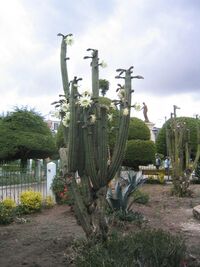Entheogen: Difference between revisions
>Josikins m Josifikins moved page Entheogens to Entheogen over redirect |
>Oskykins No edit summary |
||
| Line 1: | Line 1: | ||
[[File:Flowering San Pedro cactus.jpg|200px|thumbnail|right|Flowering San Pedro, an entheogenic cactus that has been used for over 3,000 years | [[File:Flowering San Pedro cactus.jpg|200px|thumbnail|right|Flowering San Pedro, an entheogenic cactus that has been used for over 3,000 years<ref>http://www.mescaline.com/sanpedro/</ref>]] | ||
An '''entheogen''' ("generating the divine within")<ref>http://dictionary.reference.com/browse/entheogen</ref> is a chemical substance used in a religious, shamanic, or spiritual context<ref>http://www.scielo.br/scielo.php?script=sci_arttext&pid=S1516-89132008000500010&lng=en&nrm=iso&tlng=en</ref> that may be synthesized or obtained from natural species. The chemical induces altered states of consciousness | An '''entheogen''' ("generating the divine within")<ref>http://dictionary.reference.com/browse/entheogen</ref> is a chemical substance used in a religious, shamanic, or spiritual context<ref>http://www.scielo.br/scielo.php?script=sci_arttext&pid=S1516-89132008000500010&lng=en&nrm=iso&tlng=en</ref> that may be synthesized or obtained from natural species. The chemical induces altered states of consciousness (psychological or physiological). | ||
Entheogens have been used in a ritualized context for thousands of years; their religious significance is well established in anthropological and modern evidences. Examples of traditional entheogens include [[psychedelics]] like [[peyote]], [[psilocybin mushrooms]], [[ayahuasca]], [[Tabernanthe iboga]], atypical [[hallucinogen]] like [[Salvia divinorum]] and [[Amanita muscaria]], quasi-psychedelics like [[cannabis]] and [[deliriants]] like [[datura]]. | Entheogens have been used in a ritualized context for thousands of years; their religious significance is well established in anthropological and modern evidences. Examples of traditional entheogens include [[psychedelics]] like [[peyote]], [[psilocybin mushrooms]], [[ayahuasca]], [[Tabernanthe iboga]], atypical [[hallucinogen]]s like [[Salvia divinorum]] and [[Amanita muscaria]], quasi-psychedelics like [[cannabis]] and [[deliriants]] like [[datura]]. | ||
With the advent of organic chemistry, there now exist many synthetic drugs with similar psychoactive properties, many derived from these plants. Many pure active compounds with psychoactive properties have been isolated from these respective organisms and chemically synthesized, including [[mescaline]], [[psilocybin]], [[DMT]], [[salvinorin A]], [[ibogaine]], [[ergine]], and [[muscimol]]. Semi-synthetic (e.g. [[LSD]] used by the New American Church) and synthetic drugs (e.g. [[DPT]] used by the Temple of the True Inner Light and [[2C-B]] used by the Sangoma) have also been developed.<ref>http://evolver.civicactions.net/user/chen_cho_dorge/blog/2cb_chosen_over_traditional_entheogens_south_african_healers</ref> | With the advent of organic chemistry, there now exist many synthetic drugs with similar psychoactive properties, many derived from these plants. Many pure active compounds with psychoactive properties have been isolated from these respective organisms and chemically synthesized, including [[mescaline]], [[psilocybin]], [[DMT]], [[salvinorin A]], [[ibogaine]], [[ergine]], and [[muscimol]]. Semi-synthetic (e.g. [[LSD]] used by the New American Church) and synthetic drugs (e.g. [[DPT]] used by the Temple of the True Inner Light and [[2C-B]] used by the Sangoma) have also been developed.<ref>http://evolver.civicactions.net/user/chen_cho_dorge/blog/2cb_chosen_over_traditional_entheogens_south_african_healers</ref> | ||
Revision as of 01:11, 5 June 2015

An entheogen ("generating the divine within")[2] is a chemical substance used in a religious, shamanic, or spiritual context[3] that may be synthesized or obtained from natural species. The chemical induces altered states of consciousness (psychological or physiological).
Entheogens have been used in a ritualized context for thousands of years; their religious significance is well established in anthropological and modern evidences. Examples of traditional entheogens include psychedelics like peyote, psilocybin mushrooms, ayahuasca, Tabernanthe iboga, atypical hallucinogens like Salvia divinorum and Amanita muscaria, quasi-psychedelics like cannabis and deliriants like datura.
With the advent of organic chemistry, there now exist many synthetic drugs with similar psychoactive properties, many derived from these plants. Many pure active compounds with psychoactive properties have been isolated from these respective organisms and chemically synthesized, including mescaline, psilocybin, DMT, salvinorin A, ibogaine, ergine, and muscimol. Semi-synthetic (e.g. LSD used by the New American Church) and synthetic drugs (e.g. DPT used by the Temple of the True Inner Light and 2C-B used by the Sangoma) have also been developed.[4]
More broadly, the term entheogen is used to refer to any psychoactive drugs when used for their religious or spiritual effects, whether or not in a formal religious or traditional structure. This terminology is often chosen to contrast with recreational use of the same drugs. Studies such as the Marsh Chapel Experiment have documented reports of spiritual experiences from participants who were administered psychoactive drugs in controlled trials.[5] Ongoing research is limited due to widespread drug prohibition; however, some countries have legislation that allows for traditional entheogen use.
References
- ↑ http://www.mescaline.com/sanpedro/
- ↑ http://dictionary.reference.com/browse/entheogen
- ↑ http://www.scielo.br/scielo.php?script=sci_arttext&pid=S1516-89132008000500010&lng=en&nrm=iso&tlng=en
- ↑ http://evolver.civicactions.net/user/chen_cho_dorge/blog/2cb_chosen_over_traditional_entheogens_south_african_healers
- ↑ http://www.springerlink.com/content/v2175688r1w4862x/fulltext.pdf